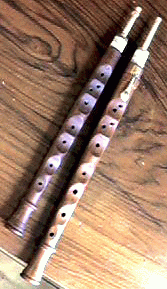|
Today, one will also find Swedish bagpipes with more drones, bellows blown instruments, and chanters in D/G and C/F. Many modifications and extensions have been made to the basic scale. The most common extension is an extra finger hole just above the c'' hole, sounding c#''. The chanter can now be played in A-major.
A distinct feature of the Swedish bagpipe chanter comes in handy here - there is a deep depression for each finger, making it almost impossible to miss a finger hole. The c#'' hole is drilled in the same depression as the c'' hole, which makes it easy to cover both with one finger when playing in A-major. To play in A-minor the c#'' hole should be covered, e.g. with bees-wax or by a leather/rubber strap.

Chanters by Alban Faust
Another common extension is a hole for the right hand's little finger, making it possible to reach low d#' or d' (depending on the length of the chanter). Since the bore is cylindrical it is easy to extend the bore length, to obtain the more generally useful bottom note of d', for example by inserting a short piece of a drinking straw at the chanter end. It is also common to have a hole for the lower hand thumb, sounding g'.
The above extensions are more or less standard today, and yields the following scale. In the recording, I have tuned the chanter to A major, i.e. with both the c'' and the c#'' hole open. Both notes are played. The bottom note is d'.

( Click the image to hear the scale)
|
It is now possible to play in the keys of A-minor, A-major, F#-minor, D-major, G-major and E-minor. Being able to play in D and G without having to swap chanters is particularly useful.
There are also chanters with an extra finger hole for the top hand index finger, just above the d'' hole (sounding d#''). This facilitates playing tunes in the key of E-major. Another extension, very rare on E/A-chanters but more common on D/G-chanters, is a small key at the top of the chanter, sounding f'' or f#'' when pressed (d#'' or e'' on a D/G-chanter). There are also playing techniques to extend the scale further.
The picture to the right shows two chanters, one in E/A (left) and one in D/G (right). The D/G chanter has all the extensions mentioned above.
Bellows blown bagpipes
Bellows blown bagpipes are filled with air from bellows tied under the free arm. This is not a new invention - such bagpipes have existed for at least 500 years in central Europe - but Swedish bagpipes in particular have only been made this way since the 1980's and are still not very common.

Bellows blown bagpipe by Alban Faust
The main reason for having bellows is that it keeps the reeds dry, and thereby easier to keep in tune. Another advantage is that it makes it possible to sing while playing, as I do in this song from Småland (played on the bellows blown bagpipe depicted above).
|




